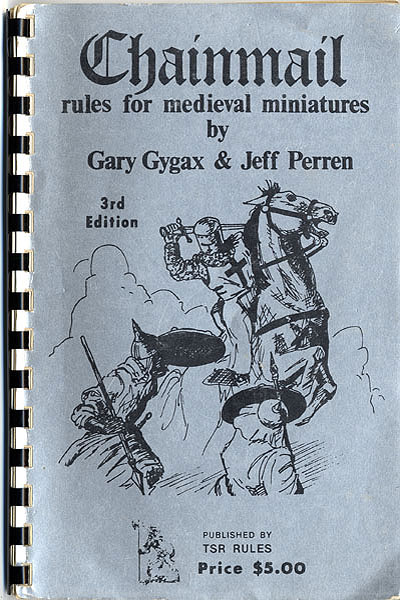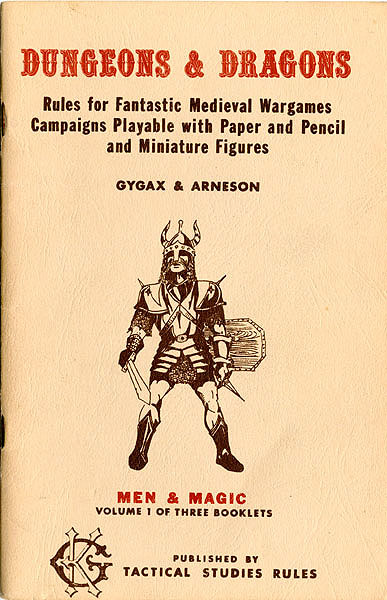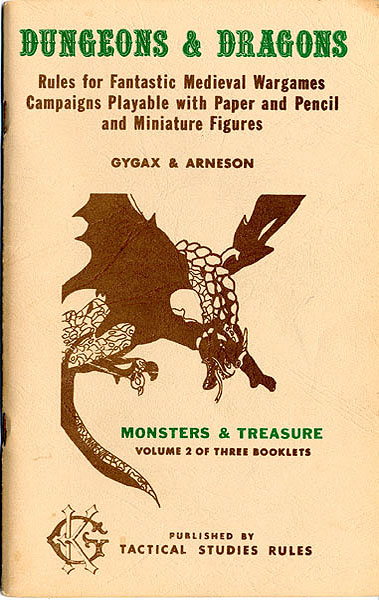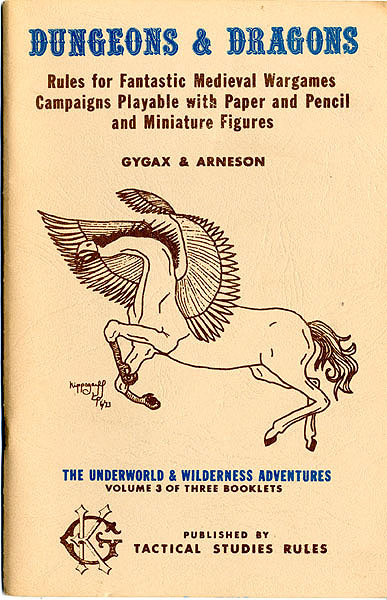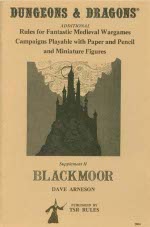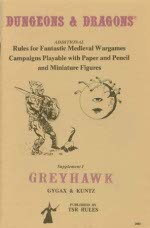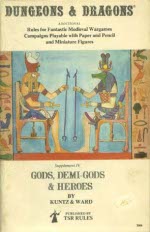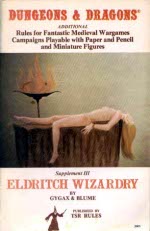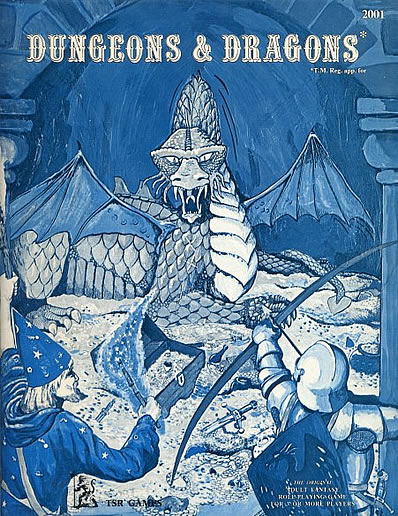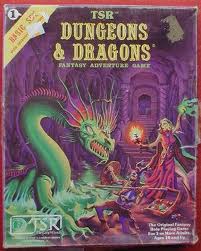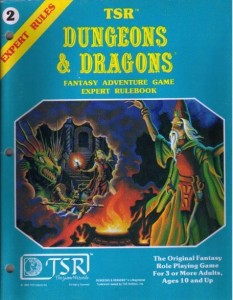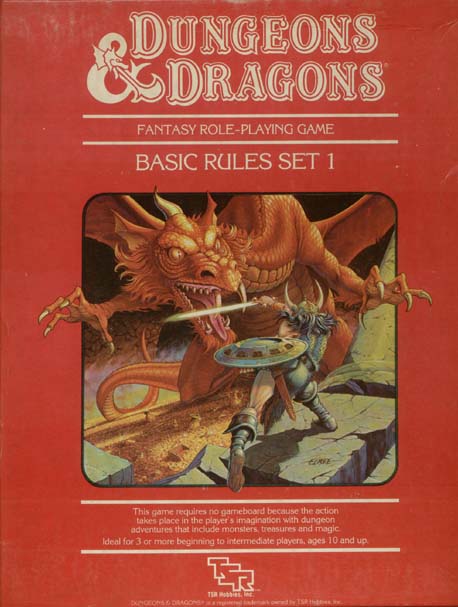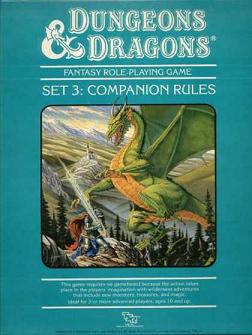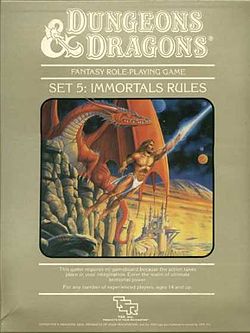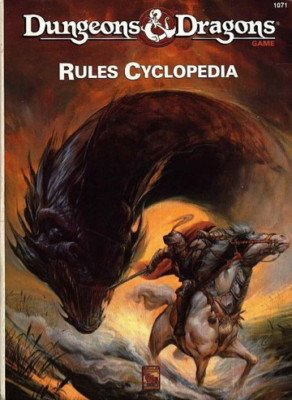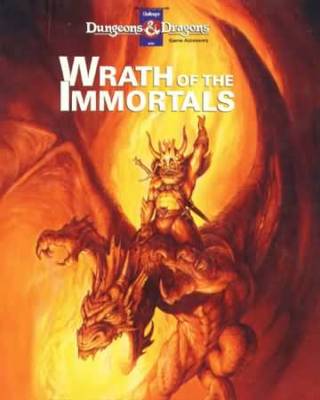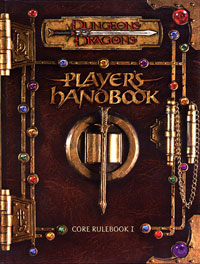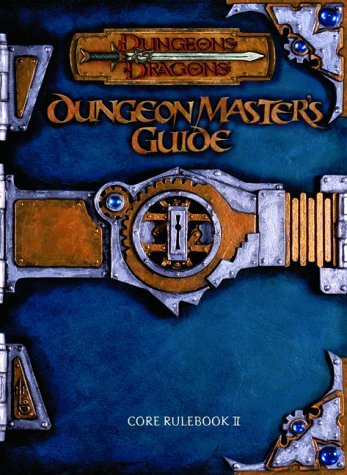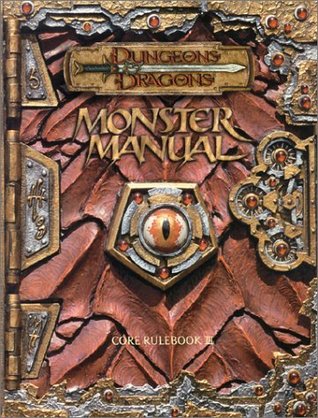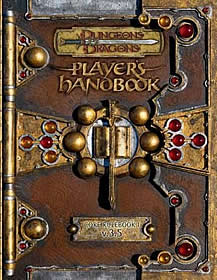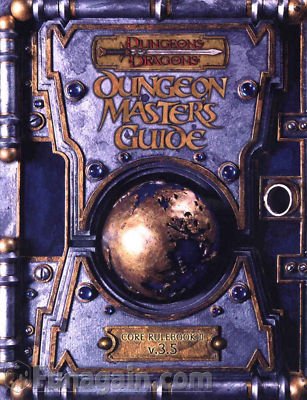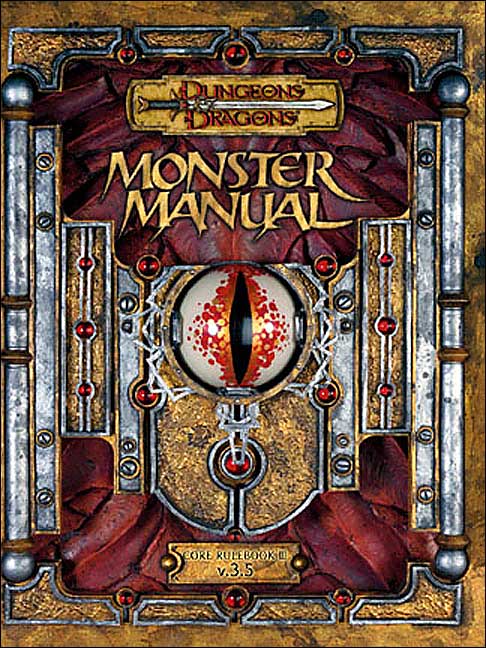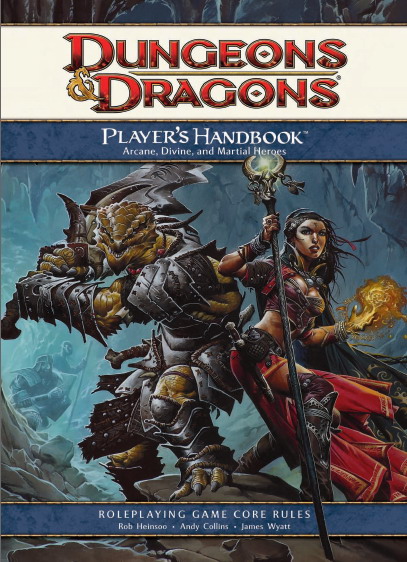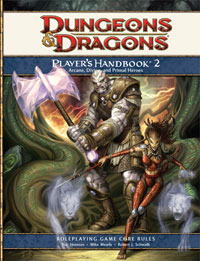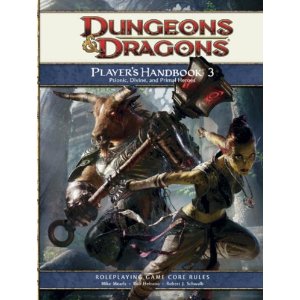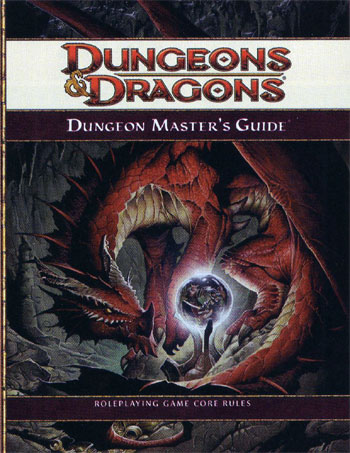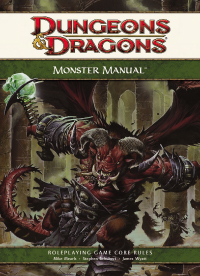Three years later, Tactical Studies Rules released a massive expansion of the ideas outlined in Chainmail's Fantasy Supplement in the form of three slim booklets entitled Dungeons & Dragons: Rules for Fantastic Medieval Wargames Campaigns Playable with Paper and Pencil and Miniature Figures. The title page of the first volume ("Men & Magic") clearly traces D&D's origins back to Chainmail
The original Dungeons & Dragons was published as a boxed set in 1974 and featured only a handful of the elements for which the game is known today: just three character classes (fighting-man, magic-user and cleric); four races (human, dwarf, elf, hobbit); only a few monsters; only three alignments (lawful, neutral, and chaotic). The rules assumed that players owned and played the miniatures wargame Chainmail and used its measurement and combat systems. An optional combat system was included within the rules that later developed into the sole combat system of later versions of the game. In addition, the rules presumed ownership of Outdoor Survival, an Avalon Hill board game for outdoor exploration and adventure (an unusual requirement, since Tactical Studies Rules was never in any way affiliated with rival Avalon Hill until two and a half decades later, when Wizards of the Coast - the purchaser of TSR's assets and trademarks - merged with Hasbro, which then owned Avalon Hill). D&D was a radically new gaming concept at the time, but the rules provided no overview of the game so it was difficult, without prior knowledge of tabletop wargaming, to see how it was all supposed to work. D&D's three rulebooks covered the spells, equipment, monsters, and combat system necessary to run a campaign centered around exploration of a giant dungeon. Four Player characters gain experience points for defeating monsters in combat and gathering treasure, and in this manner they gain levels, with each level corresponding to an incremental increase in power and ability. Characters do not gain experience points for peacefully interacting with the world, but the rules do suggest a world beyond the dungeon, even if they don't spend an enormous amount of time offering suggestions to the DM regarding how to handle its exploration. To get a hireling into service, for example, characters are expected to post notices at inns and taverns, send messengers to distant lands, or frequent public places, but the rules framework provided by the manuals focuses on the financial cost to the character rather than on social interaction. The most revealing window into the way D&D was meant to be played comes from the fact that the Dungeon Master was called “The Referee” and one player in the group was appointed as “Caller” - a player designated to speak on behalf of the group.
While the idea of a single player monopolizing the referee's time may seem strange from the perspective of a modern gamer, it must have been a necessity for a rules system that suggested an optimal player-to-referee ratio of 20:1. The assumption of such a large group of players came partly from the game's wargaming roots, but also from the enormous popularity of Arnesons and Gygax's campaigns,
Blackmoor Greyhawk Gods, demi gods and heroes Eldritch Wizardry
The release of the Greyhawk Supplement removed the game's dependency on the Chainmail rules, and made it much easier for new, non-wargaming players to grasp the concepts of play. Ironically, the ambiguities and obscurities of the original rules helped D&D's success as individual groups had to develop their own rulings and ways of playing and thus gained a sense of ownership of the game. It also inadvertently aided the growth of competing game publishers, since just about anyone who grasped the concepts behind the game could write smoother and easier to use rules systems and sell them to the growing D&D fanbase(Tunnels & Trolls being the first such). Supplements such as Greyhawk, Blackmoor, Eldritch Wizardry and Gods, Demi-Gods and Heroes (the last predecessor of Deities and Demigods), published over the next two years, greatly expanded the rules, character classes, monsters and spells. For example, the original Greyhawk supplement introduced the thief class, and weapon damage varying by weapon (as opposed to character class). In addition, many changes were "officially" adopted into the game and published in the magazines The Strategic Review and its successor Dragon Magazine.
1977 - Dungeons & Dragons 2nd version (The branching point between D&d and AD&D)
Box set Cover Basic Rules
The Dungeons & Dragons Basic Set, a larger, more visually attractive boxed set that sought to introduce Each player creates a character or characters who may be dwarves, elves, Halflings or human fighting men, The dungeons are filled with fearsome monsters, fabulous treasure, and frightful perils. As the players engage in their handling of play. The introduction carefully contextualizes the original rules and provides the best dungeon environment. The 1974 edition's rudimentary guidelines for wilderness play are notably absent, along (presumably made irrelevant by the game's focus on low-level characters). The Basic Set's rules for non-player characters parrot those of the original game, adding nothing to an element of gaming that would see great expansion with future editions. If the Basic Set's innovation lacked breadth, it certainly delivered in depth.
1981 - Dungeons & Dragons 3rd version
Basic set Box Cover Basic rules lvl 1-3 Expert set Box cover Expert rules lvl 4-14
In 1981, the "basic" version of Dungeons & Dragons was revised by Tom Moldvay and split into several versions.
The Basic and Expert sets are sometimes referred to as "red-box" and "blue-box" D&D.
This version of the basic set included a larger 64-page rule book with a color cover by Erol Otus with a red border,
This edition drew solely on the original D&D boxed set for inspiration, rather than including material from its supplements. With the revision of the Basic Set, discrete sets of increasing power levels began to be introduced as expansions for the
The Moldvay Basic Set was immediately followed by the accompanying release of an
1983 - Dungeons & Dragons 4th version
Basic rules lvl 1-3 Expert Rules lvl 4-14 Companion Rules lvl 5-25 Master Rules lvl 26-36 Immortal Rules lvl 36+
The Basic Set was revised once more in 1983 by Frank Mentzer. Here TSR took a different tack. The Player's Manual contained a six-page choose your own adventure style introduction with you playing a male fighter venturing into There is also another, larger adventure that you can play in the same style later, where it asks you to map as you go along. Other than this, the manual just presents the various character classes, spells, and miscellaneous items. The Dungeon Master's Rulebook has a sample adventure with boxed text that is ready to run. The first challenge in the After the adventure comes various procedures with explanations for abilities and spells, monsters, treasure, and tips on creating dungeons.
1991 - Dungeons & Dragons 5th version
Rules Cyclopedia lvl 1-36 Wrath of Immortals lvl 36+
The D&D Rules Cyclopedia released in 1991 was a 300-page hardback book that collated the vast majority of the Classic D&D rules Basically, if it’s in D&D, it’s in this book. To get the equivalent content in D&D 3rd Edition (see below) It was not only a complete set but the whole content was well structured and hanged well together as a whole. In the Rules Cyclopedia, the classes contains Fighter, Thief, Magic-User and Cleric – all of whom are Human – and the demi human “classes”
2000 - Dungeons & Dragons 3rd Edition (Technically 6th version) (Merging with the discontinued Advanced Dungeons & Dragons 2nd edition)
Players Handbook Dungeon Masters guide Monster Manual I
In 2000, Wizards of the Coast (who had purchased TSR two years earlier) decided to reinvent the franchise,
As part of an effort to simplfy the game, they dropped the word "Advanced," and simply called it "Dungeons & Dragons."
It rationalizes movement and combat (especially ranged combat), removes lots of arbitrary restrictions.
The formalisation and release of the d20 system chose Wizards of the Coast to call an "open source" version 2003 - Dungeons & Dragons Revised 3rd Edition (version 3.5)
Apart from the revision of the classes and spells and inclusion of erratta published to the 3rd edition no material The Ranger class has been updated. Their front-heaviness has been scaled right back, and they get the option of an archery
Animal companions for druids and rangers have been completely reworked – they now only receive one companion who
Rogues and Barbarians have become slightly better at avoiding traps, and Bards and Sorcerers can lose a spell every
Monks unarmed attacks have also been reworked, making them much more streamlined.
Diagonal movement has been complicated, one little change which makes it slightly harder for those trying to run
A lot of new feats have been added, although most of them are ‘+2 to two skills’.
Ambidexterity has been incorporated into Two-Weapon Fighting, boosting up the prerequisites for the latter but all in all making
A few new skills have been added, and a couple of old ones have been dropped.
The spell section has undergone a minor revamp. A lot of the old unbalanced spells have been altered and all the stat boost spells
The DM guide does not contain any material new content. Mostly, the new material consists of stuff culled from V.3.0 supplements
The new monster manual is significantly improved compared to v.3.0. With new art and a new organization. Templates have been Monsters suitable for use as PCs (Drow, aasimar and teiflings etc.) have full racial stats so you don’t have to work them 2008, 2009, 2010 - Dungeons & Dragons 4th Edition
Players Handbook 1 Players Handbook 2 Players Handbook 3 Dungeon Masters Guide Monster Manual I
D&D 4th edition is the radical replacement for the previous version 3 and 3.5. It is a new game system appealing to easily new players, more combat oriented players, power builders and a lower-hassle game
Character building and leveling is a lot faster, trading again simplicity for speed and less rule look ups. It takes approximately 25% of the D&D 4th edition gives significant fewer options in combat, skills, feat and equipment – but due to increased power of the classes and races
A few examples of the 4th edition is more or less a new game system fully disconnected to D&D 3.5:
The character build is lot more like a World of Warcraft tree than what is known from previous D&D editions. All characters uses “powers”
In addition emphasis has been put on developing strong roles for both monsters and players, making combat a real interplay of tank/healer/crowd controller/ Damage dealer roles as known from MMORPG
|


